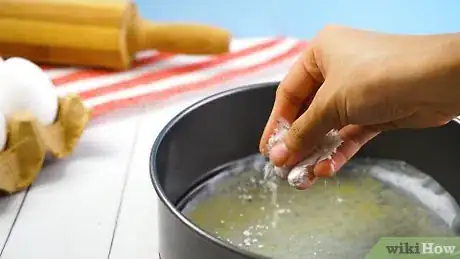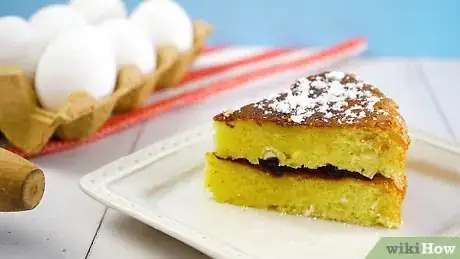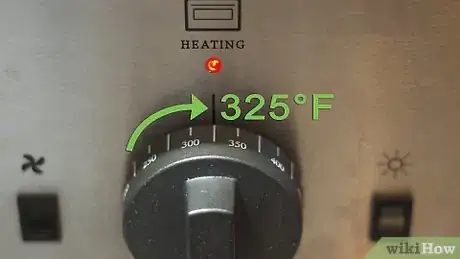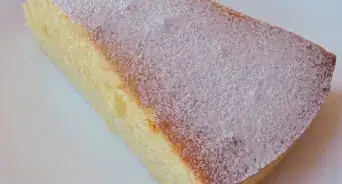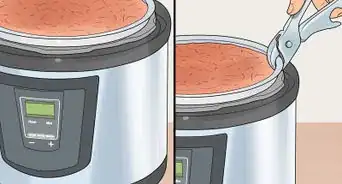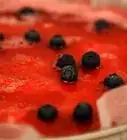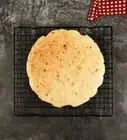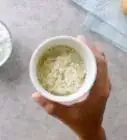This article was co-authored by Jennifer Levasseur. Chef Jennifer Levasseur is a Personal Chef and the Owner of The Happy Cuisiniere based in Breckenridge, Colorado. She has over 12 years of culinary experience and specializes in Mountain and Contemporary Rustic cuisine. Moreover, she can craft dishes and modify menus to accommodate dietary restrictions, such as gluten-free, vegetarian, vegan, pescatarian, and dairy-free diets. In addition to a Bachelor’s degree in Marketing and Management from the University of Houston, Chef Jennifer holds Associate’s degrees in Culinary Arts and Baking & Pastry Arts from Houston Community College.
wikiHow marks an article as reader-approved once it receives enough positive feedback. In this case, several readers have written to tell us that this article was helpful to them, earning it our reader-approved status.
This article has been viewed 1,008,595 times.
Few cakes are as customizable as simple sponge cakes. Baked in sheet, cake, or tube pans, they can be dressed up by adding frostings, icings, and whipped cream, or served simply as a slightly sweet accompaniment to tea. Sponge cakes rely on well-beaten eggs to give them volume, but you can modify the texture of a sponge cake by what fat you use. A simple sponge cake that uses butter can be made in sheet pans or cake pans. It's fluffy, light, and rolls easily. A chiffon cake relies on oil and uses more flour. This creates a sturdier cake that can stand up to heavier frostings or buttercream. Choose a sponge cake, bake it in a pan of your choice, and frost it to make it your own.
Ingredients
- 4 tablespoons unsalted butter, melted and cooled, plus more for pans
- 1 1/2 cups (210 g; 7.4 oz) cake flour, plus more for pans
- 9 large eggs, room temperature, white and yolks separated
- 1 1/2 cups (340 g; 12 oz) sugar, divided
- 1 teaspoon vanilla extract
- pinch of kosher salt
- powdered/confectioner's sugar, for dusting
- 2 1/4 cups (350 g; 12.4 oz) cake flour
- 1 1/2 cups (340 g; 12 oz) sugar, divided
- 2 1/4 teaspoon baking powder
- 3/4 teaspoon salt
- 1/2 cup (125 ml; 4.2 fl oz) neutral oil, such as canola, vegetable, or sunflower (do not use olive oil)
- 7 large egg yolks
- 9 large egg whites
- 3/4 cup (185 ml; 6.2 fl oz) whole milk
- 1/2 teaspoon cream of tartar
- 2 teaspoons vanilla extract
Steps
Making a Simple Sponge Cake
-
1Heat the oven and prepare your pans. Set the oven to 180°C, 350°F, or gas mark 4. Butter two 9-inch (22.86-cm) cake pans or two 12-by-17-inch (30.48-by-43.18-cm) rimmed baking sheets. Line the bottom of your pans with parchment paper, butter the paper, and then sprinkle flour all over it. Gently shake the flour around and shake the excess out of the pan.[1]
- Don't be tempted to skip the parchment paper. It will ensure that the cake doesn't stick to the pans and will make it easy to remove.
-
2Set up a bain marie. Pour water into a saucepan and get it simmering, or slightly bubbling. Place a bowl over the saucepan taking care that the bowl doesn't touch the water.[2]
- You can also buy and use a double boiler, which similarly nests two saucepans.
Advertisement -
3Add egg yolks and 1 cup (225 g; 7.9 oz) of sugar to the bowl. Whisk till the yolks and sugar over the simmering water until the sugar dissolves, about 3 or 4 minutes.[3] When you no longer see sugar granules, remove the bowl from heat.
- To separate your eggs, crack them all into a bowl first. Then, scoop up the egg yolks one at a time and separate your fingers so the white falls back into the bowl.
-
4Beat the yolk/sugar mixture. Use a hand-mixer on medium-high to beat the mixture until it lightens in color and thickens slightly, about 3 to 5 minutes. Stir in vanilla extract and salt. Pour the mixture into a large bowl.
-
5Beat egg whites. Place the whites in a separate large bowl and beat with a mixer on high speed. Beat till soft peaks form. These should be slightly droopy if you lift the beaters out of the bowl. Once this happens, beat in the rest of your sugar until the peaks become stiff and shiny. This should take a couple of minutes.
- Be sure to use spotlessly clean beaters and a bowl. If there's any trace of grease or fat, your egg whites won't form peaks.
- Make sure that no egg yolks mix in with your egg whites, either.
-
6Fold the whites into the yolks. Do this gradually, by folding in one third of the whites at a time. Then, gently sift the flour over the top and fold it in as well. Stop folding just before all the flour is incorporated.
- To fold in a mixture, simply use a spatula and a light hand to gently combine a lighter mixture into a heavier one. Avoid stirring, or you'll lose the volume of the lighter mixture. Instead, rotate your wrist when combining substances.
-
7Pour in the melted butter. Pour it down the side of the bowl and fold it into the batter until it's smooth, but take care not to overbeat.
-
8Spread the batter in pans and bake. Divide the batter between your two cake pans or sheets. Bake the cake pans for around 25 minutes or 15 minutes for the sheet pans. To ensure even browning, rotate the pans or sheets halfway through the baking time. The cake is done when a tester or toothpick comes out clean after being stuck in the center.[4]
-
9Remove from the sheets or pans. If you used cake pans, hold a plate over the cake, then swiftly turn it upside down so the cake comes out onto the plate. Remove the parchment and then use the same method to flip it onto your serving plate.
- If you used sheets, lay out a few kitchen towels and dust them with the powdered/confectioner's sugar. Immediately flip the hot cakes onto the dusted towels. Dust the top of the cakes with more powdered/confectioner's sugar and then roll up the cakes in the towels. Let them cool for at least an hour. Unroll them before filling.
-
10Frost or fill, as desired. Sponge cakes baked in cake pans easily lend themselves to filling between the layers. Sponge cakes baked in sheet pans can be filled and rolled before being frosted on the outside.
- Try making a Buche de Noel. Take your prepared sponge cake made in a sheet pan and fill with your choice of chocolate, chestnut, coffee, or cream cheese fillings. Roll it up and cover with a frosting of your choice (typically, a chocolate). Decorate the rolled up cake to look like a Yule log by adding meringue mushrooms, holly, and sugared cranberries. Dust with powdered sugar.
- Try making a Victoria Sponge. Place one of your sponge cakes made in the cake pan onto your serving plate. Spread raspberry jam overtop or scatter with fresh berries. Dollop whipped cream or buttercream over the jam or fruit and spread. Stack the other sponge cake on top of the fruit and cream, then dust with powdered/confectioner's sugar and serve.[5]
Making a Chiffon Cake
-
1Heat the oven and set out your pan. Set the oven to 165°C, 325°F, or gas mark 3. Have a tube pan ready, but do not butter or grease it.
-
2Whisk your dry ingredients. Whisk together the flour, 3/4 cup (170 g; 6 oz) of the sugar, the baking powder, and salt in a medium bowl.[6]
-
3Whisk your wet ingredients. In a separate large bowl, whisk together the oil, egg yolks, and milk till combined. Gradually whisk the flour mixture into your wet mixture.[7]
-
4Beat the egg whites. In a separate bowl, beat the egg whites with a mixer set to high until the whites become frothy. Add the cream of tartar and vanilla, then beat until the whites hold soft peaks. Slowly beat in the rest of the sugar (3/4 cup; 170 g or 6 oz) and keep beating until the whites hold stiff, shiny peaks. This should take around 5 minutes.
-
5Whisk the egg whites into your batter. Start by whisking in a third of the egg whites into your other batter. Then, take a spatula and gently fold the rest of the egg whites into the mixture. Stop folding just before all the flour is incorporated.
- To fold in a mixture, simply use a spatula and a light hand to gently combine a lighter mixture into a heavier one. Avoid stirring, or you'll lose the volume of the lighter mixture. Instead, rotate your wrist when combining substances.
-
6Spread in tube pan and bake. Cook the cake until it springs back when you touch it, around 50 to 55 minutes. Remove it from the oven and let it cool upside down for an hour before you take it out of the pan.
- To let the cake easily cool upside down, try setting the pan upside down over a bottle inserted in the center of the pan.
-
7Frost or fill, as desired. Chiffon cakes can be sliced vertically, like an Angel Food cake, or cut horizontally and filled, like a Victoria Sponge.
Community Q&A
-
QuestionWhat temperature should the eggs be?
 wikiHow Staff EditorThis answer was written by one of our trained team of researchers who validated it for accuracy and comprehensiveness.
wikiHow Staff EditorThis answer was written by one of our trained team of researchers who validated it for accuracy and comprehensiveness.
Staff Answer wikiHow Staff EditorStaff AnswerFor a sponge cake, use room temperature eggs. Avoid using refrigerated eggs unless they've been warmed at room temperature first.
wikiHow Staff EditorStaff AnswerFor a sponge cake, use room temperature eggs. Avoid using refrigerated eggs unless they've been warmed at room temperature first. -
QuestionWhat are some good fillings for sponge cakes?
 wikiHow Staff EditorThis answer was written by one of our trained team of researchers who validated it for accuracy and comprehensiveness.
wikiHow Staff EditorThis answer was written by one of our trained team of researchers who validated it for accuracy and comprehensiveness.
Staff Answer wikiHow Staff EditorStaff AnswerGood fillings for a sponge cake include: Jam or jelly, custard, cream or mock cream, ganache or microwave melted chocolate, or fresh fruit (pureed or chopped small).
wikiHow Staff EditorStaff AnswerGood fillings for a sponge cake include: Jam or jelly, custard, cream or mock cream, ganache or microwave melted chocolate, or fresh fruit (pureed or chopped small). -
QuestionHow long can I keep a sponge cake for?
 wikiHow Staff EditorThis answer was written by one of our trained team of researchers who validated it for accuracy and comprehensiveness.
wikiHow Staff EditorThis answer was written by one of our trained team of researchers who validated it for accuracy and comprehensiveness.
Staff Answer wikiHow Staff EditorStaff AnswerSponge cakes are best eaten fresh, on the day of baking. However, if kept in a cool room, they can last up to 3 days. Refrigerate if using a dairy filling or topping.
wikiHow Staff EditorStaff AnswerSponge cakes are best eaten fresh, on the day of baking. However, if kept in a cool room, they can last up to 3 days. Refrigerate if using a dairy filling or topping.
Warnings
- Avoid over-mixing your batter. If you do, you will have a much heavier cake and it will not carry the fluffiness of a sponge. If you do end up with a heavier cake, just cut it up and use it as the basis for a trifle.⧼thumbs_response⧽
Things You'll Need
- Mixer with beaters and whisk attachments
- Rubber spatula
- Two 9" (22.86-cm) cake pans or two 12x17" (30.48 x 43.18-cm) rimmed sheet pans
- Parchment paper
- Bain marie or double boiler
- 2 bowls
- Sieve or flour sifter
- Wooden skewer or toothpick
- Kitchen towel, if using sheet pan
References
- ↑ https://www.bbcgoodfood.com/recipes/sponge-cake
- ↑ https://www.thekitchn.com/technique-how-to-make-and-use-70190
- ↑ https://cooking.nytimes.com/recipes/1022270-sponge-cake
- ↑ https://www.bbcgoodfood.com/recipes/sponge-cake
- ↑ https://www.bbcgoodfood.com/recipes/classic-victoria-sandwich-recipe
- ↑ https://www.allrecipes.com/recipe/7892/chiffon-cake/
- ↑ https://www.allrecipes.com/recipe/7892/chiffon-cake/
- ↑ https://www.bbcgoodfood.com/recipes/chocolate-sponge-cake
About This Article
To make a sponge cake, heat egg yolks and sugar in a double boiler, whisking constantly, until the sugar is completely dissolved. Beat the yolk and sugar mixture for 3-5 minutes, then stir in the vanilla and salt. Beat the egg whites in a separate bowl until soft peaks form, then gently fold them into the yolk mixture. Sift the flour over the top and fold it in as well. Pour in melted butter and fold it into the batter just until it’s smooth. Spread the batter into buttered pans and bake at 350°F for around 25 minutes or until a toothpick comes out clean after being stuck in the center. If you want to learn more, like how to make a heavier chiffon cake, keep reading the article!
